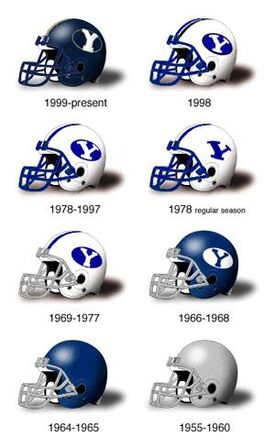
1950-1954 -- Solid white helmet with a single blue stripe running down the center.
1955-1960 -- The white helmet was replaced with a solid silver helmet with no logos, numbers or stripes.
1961-1963 -- After six years with a plain silver helmet, blue player numbers are added to each side of the helmet.
1964-1965 -- The silver helmet is traded in for plain blue helmets and were remained unchanged for two seasons.
1966-1968 -- A blue "Y" placed in the middle of a white oval was added to the solid blue helmet.
1969 -- The colors on the helmet are inversed. For the next three decades, BYU fans will grow accustomed to the white helmet with the traditional blue decal.
1970 -- BYU equipment manager Floyd Johnson implements the use of his own invention. "Cage loops", a small leather strap that held the facemask to the helmet, are placed on each helmet. The invention, now a plastic device, provided additional cushion and protection for collisions and eventually evolved into a standard element used on all helmets from the NFL down to the high school level.
1978 -- For a single season, the Cougars experimented with a new design in which the white "Y" inside the blue oval was removed and a solid blue "Y" was used. Coaches began rewarding players for big plays with little blue stickers (cougar heads) to be placed on the player's helmet.
1979 -- After losing four games in 1978, the most losses since 1975, the blue oval with white "Y" returned to the helmet and the Cougars went on to post an 11-1 mark and claim the WAC title.
1993 -- Black is added as a third color on the helmet, used primarily to accent the blue decals and also as a trim on the uniforms.
1994 -- Players vote to discontinue the use of the cougar-head stickers, claiming the stickers favored the skill positions and hurt team unity. UNIFORM NOTE: Beginning with the 1994 Copper Bowl, black is used as a drop-back color on the uniforms, giving a three-dimensional effect to several elements of the jersey. The NCAA originally denied BYU's request to make the change, but conceded following an appeal. many other schools now use an accent color scheme on their uniforms. The players also begin using black gloves and shoes. The light blue facemasks are traded in for a darker color, "Seattle Blue".
1998 -- Two black stripes, separated by a blue stripe is added to the crown of the helmet, replacing the two blue stripes, which was separated by a single white stripe.
1999 -- (August 16) BYU unveils its new logo and colors, complete with new football uniforms and helmets. A darker shade of blue and white become the official colors of the University, with tan serving as the primary accent color. The re-birth of the blue helmet in 1999 is the first time BYU has worn a different color, other than white, for over 30 years. The new logo on the side of the helmet, similar to the traditional side decal, is the first new design used on a BYU helmet since 1978. The new uniforms represent a new and flashy look, never before used on the collegiate playing field. The new-look uniforms and helmets represent the first major uniform change under the LaVell Edwards era.